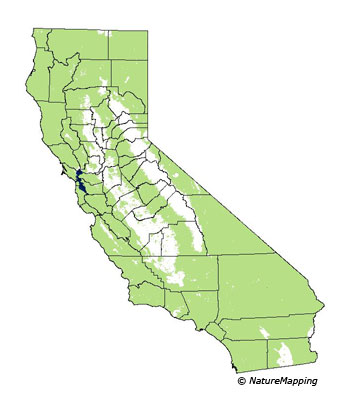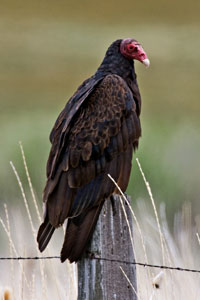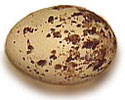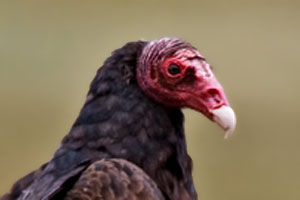
Home | About Us | Projects | Maps | Facts

Home | About Us | Projects | Maps | Facts

Turkey Vulture (Cathartes aura) The naked red heads of the adult turkey vultures resemble those of turkeys, hence the name. Their genus name, Cathartes, means "cleanser" because that's what they do: clean up carcasses from woods and roads. Description: The Turkey Vulture is a large soaring bird that feeds on carrion (the dead and rotting body of an animal). It's recognized by the featherless red head, white bill, large brown-black body and yellow feet. They can be easily spotted along roadways displaying their long wingspan and smooth soaring flight. While soaring it holds the wings slightly up in a V-shape. The wingspan extends to 170-178 cm (67-70 in). Weight: 2000 g (70.6 ounces) Size: 64-81 cm (25-32 in) 
Calls:
Usually silent. Makes hiss at carcasses, roosts, and nest. Range/ Habitat: The Turkey Vultures breeds from southern Canada throughout the United States and southward through southern South America and the Caribbean. This species is common in the lower forest zones and the steppe zones. It nests in small caves or ledges on high cliffs in these regions. Click the range map to learn more about the distribution of Turkey Vultures in California. Diet: Turkey Vultures eat a wide variety of carrion, from small mammals to dead cows. Also some insects, other invertebrates, and some fruit are consumed. 
Nesting: The is no nest structure. The female Turkey Vulture lays 1 to 3 eggs directly on ground in caves, crevices, mammal burrows, hollow logs, under fallen trees, or in abandoned buildings. The eggs are creamy-white with dark blotches around large end. Behavior: Turkey vultures are almost exclusively scavengers (Cathartes means "purifier"), so this species rarely kills small animals. They form communal roosts which facilitate group foraging and social interactions. The roosts range in size from a few birds to several thousand. Turkey Vultures are often seen standing in a spread-winged stance - called the "horaltic pose." The horaltic pose is believed to serve multiple functions: drying the wings, warming the body, and baking off bacteria. 
Groups of vultures spiraling upward to gain altitude are called "kettles". As vultures catch thermal updrafts they take on the appearance of water boiling in a pot – hence the name kettle. Why do turkey vultures defecate on their feet?During the hot weather, turkey vultures will defecate on their feet to cool them off. Since a vulture's digestive juices kill bacteria--which is why vultures don't get sick from eating rotten meat--defecating on their legs might even work as an antiseptic wash. Why do turkey vultures vomit?Their method of self-defense is to vomit their food, which they can send sailing 10 feet. If a turkey vulture is disturbed or harassed, it will throw up on the animal who is bothering it. Even the vulture babies will vomit on other animals. Though these behaviors might distress people, they serve turkey vultures well. Vulture vomit is an effective predator repellent. Did you know?:
Animal silhouettes available to purchase » Photos: Natures Pics More informationAll About Birds: Turkey Vulture Birds of North American Online: Turkey Vulture Kern Valley Vulture Wath - Turkey Vulture Facts |